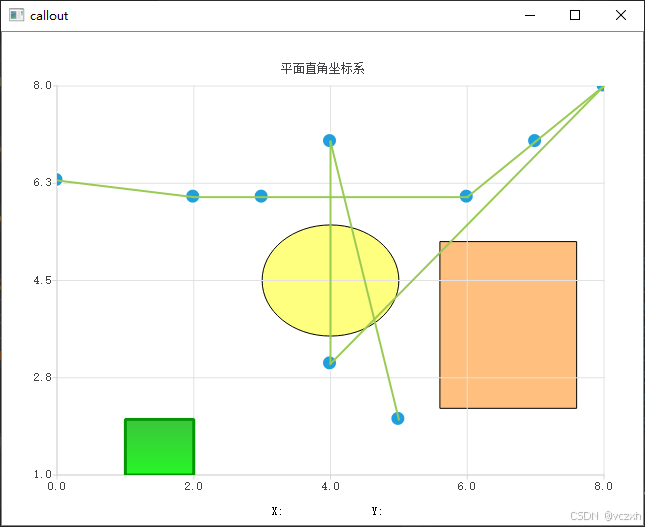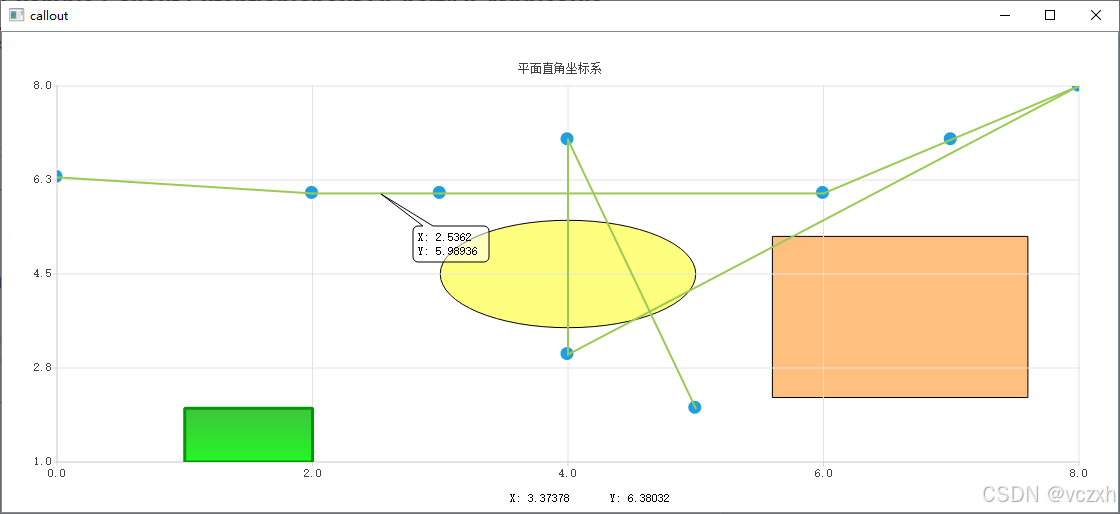本文主要是介绍Qt Example Callout Extention(about QChart/QGraphicsView/QGraphicsItem),希望对大家解决编程问题提供一定的参考价值,需要的开发者们随着小编来一起学习吧!
问题
Qt Example callout 展示了在平面直角坐标系中画tips。知识点涉及到QChart/QGraphicsView/QGraphicsItem。如何在平面直角坐标系中画点、折线、圆、长方形?
Example路径
D:\Qt\5.15.2\Src\qtcharts\examples\charts\callout\callout.cpp
代码
main
#include <QtWidgets/QApplication>
#include "view.h"int main(int argc, char *argv[])
{QApplication a(argc, argv);View w;w.show();return a.exec();
}
View
#ifndef VIEW_H
#define VIEW_H
#include <QtWidgets/QGraphicsView>
#include <QtCharts/QChartGlobal>QT_BEGIN_NAMESPACE
class QGraphicsScene;
class QMouseEvent;
class QResizeEvent;
QT_END_NAMESPACEQT_CHARTS_BEGIN_NAMESPACE
class QChart;
QT_CHARTS_END_NAMESPACEclass Callout;QT_CHARTS_USE_NAMESPACE
class CircleItem;
class RectItem;
class View: public QGraphicsView
{Q_OBJECTpublic:View(QWidget *parent = 0);void DelCallout(Callout* pCallout);
protected:void resizeEvent(QResizeEvent *event);void mouseMoveEvent(QMouseEvent *event);public slots:void keepCallout();void tooltip(QPointF point, bool state);private:QGraphicsSimpleTextItem *m_coordX;QGraphicsSimpleTextItem *m_coordY;QChart *m_chart;Callout *m_tooltip;QList<Callout*> m_lCallout;QList<CircleItem*>m_lCircle;QList<RectItem*>m_lRect;
};#endif
#include "view.h"
#include <QtGui/QResizeEvent>
#include <QtWidgets/QGraphicsScene>
#include <QtCharts/QChart>
#include <QtCharts/QLineSeries>
#include <QtCharts/QSplineSeries>
#include <QtWidgets/QGraphicsTextItem>
#include "callout.h"
#include <QtGui/QMouseEvent>
#include <QValueAxis>
#include <QScatterSeries>
#include <QAreaSeries>
#include <QSplineSeries>
#include "CircleItem.h"
#include "RectItem.h"
View::View(QWidget *parent): QGraphicsView(new QGraphicsScene, parent),m_coordX(0),m_coordY(0),m_chart(0),m_tooltip(0)
{setDragMode(QGraphicsView::NoDrag);setVerticalScrollBarPolicy(Qt::ScrollBarAlwaysOff);setHorizontalScrollBarPolicy(Qt::ScrollBarAlwaysOff);// chartm_chart = new QChart;m_chart->setMinimumSize(640, 480);m_chart->setTitle(QStringLiteral("平面直角坐标系"));m_chart->legend()->hide();//点的数据源QList<QPointF> lptSource;lptSource << QPointF(0, 6.3) << QPointF(2, 6) << QPointF(3, 6) << QPointF(6, 6) << QPointF(7, 7) << QPointF(8, 8)<< QPointF(4, 3) << QPointF(4, 7) << QPointF(5, 2);//点用折线连起来QLineSeries* line = new QLineSeries();line->append(lptSource);//点用曲线连起来QSplineSeries* spline = new QSplineSeries();spline->append(lptSource);//点用圆圈表示QScatterSeries* scatter = new QScatterSeries();scatter->append(lptSource);//区域QLineSeries* line1 = new QLineSeries();QLineSeries* line2 = new QLineSeries();line1->append(1, 1);line1->append(1, 2);line2->append(2, 1);line2->append(2, 2);QAreaSeries* area = new QAreaSeries(line1, line2);area->setName("Batman");QPen pen(0x059605);pen.setWidth(3);area->setPen(pen);QLinearGradient gradient(QPointF(0, 0), QPointF(0, 1));gradient.setColorAt(0.0, 0x3cc63c);gradient.setColorAt(1.0, 0x26f626);gradient.setCoordinateMode(QGradient::ObjectBoundingMode);area->setBrush(gradient);m_chart->addSeries(scatter);m_chart->addSeries(line);//m_chart->addSeries(spline);m_chart->addSeries(area);m_chart->createDefaultAxes();m_chart->setAcceptHoverEvents(true);setRenderHint(QPainter::Antialiasing);scene()->addItem(m_chart);m_coordX = new QGraphicsSimpleTextItem(m_chart);m_coordX->setPos(m_chart->size().width()/2 - 50, m_chart->size().height());m_coordX->setText("X: ");m_coordY = new QGraphicsSimpleTextItem(m_chart);m_coordY->setPos(m_chart->size().width()/2 + 50, m_chart->size().height());m_coordY->setText("Y: ");connect(line, &QLineSeries::clicked, this, &View::keepCallout);connect(line, &QLineSeries::hovered, this, &View::tooltip);connect(spline, &QSplineSeries::clicked, this, &View::keepCallout);connect(spline, &QSplineSeries::hovered, this, &View::tooltip);connect(area, &QAreaSeries::clicked, this, &View::keepCallout);connect(area, &QAreaSeries::hovered, this, &View::tooltip);this->setMouseTracking(true);CircleItem* pCircle = new CircleItem(m_chart, this);pCircle->SetCenterR(QPointF(4,4.5),1);m_lCircle.push_back(pCircle);RectItem* pRect = new RectItem(m_chart, this);pRect->SetRect(QRectF(QPointF(5.6,2.2),QSizeF(2,3)));m_lRect.push_back(pRect);
}void View::DelCallout(Callout* pCallout)
{m_lCallout.removeOne(pCallout);delete pCallout;
}void View::resizeEvent(QResizeEvent *event)
{if (scene()) {scene()->setSceneRect(QRect(QPoint(0, 0), event->size()));m_chart->resize(event->size());m_coordX->setPos(m_chart->size().width()/2 - 50, m_chart->size().height() - 20);m_coordY->setPos(m_chart->size().width()/2 + 50, m_chart->size().height() - 20);const auto callouts = m_lCallout;for (Callout *callout : callouts)callout->updateGeometry();for (CircleItem* pCircle : m_lCircle)pCircle->updateGeometry();for (RectItem* pRect : m_lRect)pRect->updateGeometry();}QGraphicsView::resizeEvent(event);
}void View::mouseMoveEvent(QMouseEvent *event)
{m_coordX->setText(QString("X: %1").arg(m_chart->mapToValue(event->pos()).x()));m_coordY->setText(QString("Y: %1").arg(m_chart->mapToValue(event->pos()).y()));QGraphicsView::mouseMoveEvent(event);
}void View::keepCallout()
{m_lCallout.append(m_tooltip);m_tooltip = new Callout(m_chart, this);
}void View::tooltip(QPointF point, bool state)
{if (m_tooltip == 0)m_tooltip = new Callout(m_chart, this);if (state) {m_tooltip->setText(QString("X: %1 \nY: %2 ").arg(point.x()).arg(point.y()));m_tooltip->setAnchor(point);m_tooltip->setZValue(11);m_tooltip->updateGeometry();m_tooltip->show();} else {m_tooltip->hide();}
}
callout
#ifndef CALLOUT_H
#define CALLOUT_H#include <QtCharts/QChartGlobal>
#include <QtWidgets/QGraphicsItem>
#include <QtGui/QFont>QT_BEGIN_NAMESPACE
class QGraphicsSceneMouseEvent;
QT_END_NAMESPACEQT_CHARTS_BEGIN_NAMESPACE
class QChart;
QT_CHARTS_END_NAMESPACEQT_CHARTS_USE_NAMESPACE
class View;
class Callout : public QGraphicsItem
{
public:Callout(QChart *parent, View* pView);void setText(const QString &text);void setAnchor(QPointF point);void updateGeometry();QRectF boundingRect() const;void paint(QPainter *painter, const QStyleOptionGraphicsItem *option,QWidget *widget);protected:void mousePressEvent(QGraphicsSceneMouseEvent *event);void mouseMoveEvent(QGraphicsSceneMouseEvent *event);void mouseDoubleClickEvent(QGraphicsSceneMouseEvent* event);
private:QString m_text;QRectF m_textRect;QRectF m_rect;QPointF m_anchor;QFont m_font;QChart *m_chart;View* m_view;
};#endif // CALLOUT_H
#include "callout.h"
#include <QtGui/QPainter>
#include <QtGui/QFontMetrics>
#include <QtWidgets/QGraphicsSceneMouseEvent>
#include <QtGui/QMouseEvent>
#include <QtCharts/QChart>
#include <QDebug>
#include <view.h>
Callout::Callout(QChart *chart, View* pView):QGraphicsItem(chart),m_chart(chart),m_view(pView)
{
}QRectF Callout::boundingRect() const
{QPointF anchor = mapFromParent(m_chart->mapToPosition(m_anchor));QRectF rect;rect.setLeft(qMin(m_rect.left(), anchor.x()));rect.setRight(qMax(m_rect.right(), anchor.x()));rect.setTop(qMin(m_rect.top(), anchor.y()));rect.setBottom(qMax(m_rect.bottom(), anchor.y()));return rect;
}void Callout::paint(QPainter *painter, const QStyleOptionGraphicsItem *option, QWidget *widget)
{Q_UNUSED(option)Q_UNUSED(widget)QPainterPath path;path.addRoundedRect(m_rect, 5, 5);QPointF anchor = mapFromParent(m_chart->mapToPosition(m_anchor));if (!m_rect.isNull() && !m_rect.contains(anchor)) {QPointF point1, point2;// establish the position of the anchor point in relation to m_rectbool above = anchor.y() <= m_rect.top();bool aboveCenter = anchor.y() > m_rect.top() && anchor.y() <= m_rect.center().y();bool belowCenter = anchor.y() > m_rect.center().y() && anchor.y() <= m_rect.bottom();bool below = anchor.y() > m_rect.bottom();bool onLeft = anchor.x() <= m_rect.left();bool leftOfCenter = anchor.x() > m_rect.left() && anchor.x() <= m_rect.center().x();bool rightOfCenter = anchor.x() > m_rect.center().x() && anchor.x() <= m_rect.right();bool onRight = anchor.x() > m_rect.right();// get the nearest m_rect corner.qreal x = (onRight + rightOfCenter) * m_rect.width();qreal y = (below + belowCenter) * m_rect.height();bool cornerCase = (above && onLeft) || (above && onRight) || (below && onLeft) || (below && onRight);bool vertical = qAbs(anchor.x() - x) > qAbs(anchor.y() - y);qreal x1 = x + leftOfCenter * 10 - rightOfCenter * 20 + cornerCase * !vertical * (onLeft * 10 - onRight * 20);qreal y1 = y + aboveCenter * 10 - belowCenter * 20 + cornerCase * vertical * (above * 10 - below * 20);;point1.setX(x1);point1.setY(y1);qreal x2 = x + leftOfCenter * 20 - rightOfCenter * 10 + cornerCase * !vertical * (onLeft * 20 - onRight * 10);;qreal y2 = y + aboveCenter * 20 - belowCenter * 10 + cornerCase * vertical * (above * 20 - below * 10);;point2.setX(x2);point2.setY(y2);path.moveTo(point1);path.lineTo(anchor);path.lineTo(point2);path = path.simplified();qDebug() << point1 << "," << anchor << "," << point2 << "," << path<<"\n\n\n\n";}painter->setBrush(QColor(255, 255, 255,128));painter->drawPath(path);painter->drawText(m_textRect, m_text);
}void Callout::mousePressEvent(QGraphicsSceneMouseEvent *event)
{QPointF pt = event->pos();QRectF rc = mapToParent(m_rect).boundingRect();if (m_rect.contains(pt)){event->setAccepted(true);}elseevent->setAccepted(false);
}void Callout::mouseMoveEvent(QGraphicsSceneMouseEvent *event)
{if (event->buttons() & Qt::LeftButton){setPos(mapToParent(event->pos() - event->buttonDownPos(Qt::LeftButton)));event->setAccepted(true);} else {event->setAccepted(false);}
}void Callout::mouseDoubleClickEvent(QGraphicsSceneMouseEvent* event)
{m_view->DelCallout(this);
}void Callout::setText(const QString &text)
{m_text = text;QFontMetrics metrics(m_font);m_textRect = metrics.boundingRect(QRect(0, 0, 150, 150), Qt::AlignLeft, m_text);m_textRect.translate(5, 5);prepareGeometryChange();m_rect = m_textRect.adjusted(-5, -5, 5, 5);
}void Callout::setAnchor(QPointF point)
{m_anchor = point;
}void Callout::updateGeometry()
{prepareGeometryChange();setPos(m_chart->mapToPosition(m_anchor) + QPoint(10, -50));
}
CircleItem
#pragma once
#include <QtCharts/QChartGlobal>
#include <QtWidgets/QGraphicsItem>
QT_BEGIN_NAMESPACE
class QGraphicsSceneMouseEvent;
QT_END_NAMESPACEQT_CHARTS_BEGIN_NAMESPACE
class QChart;
QT_CHARTS_END_NAMESPACEQT_CHARTS_USE_NAMESPACE
class View;
class CircleItem :public QGraphicsItem
{
public:CircleItem(QChart* parent, View* pView);void SetCenterR(QPointF pt,double r);//pt为在坐标系上点的坐标,r为在坐标系上的半径长度void paint(QPainter* painter, const QStyleOptionGraphicsItem* option, QWidget* widget);void updateGeometry();QRectF boundingRect() const;
private:QPointF m_pt,m_ptDraw;double m_r,m_rDrawW,m_rDrawH;QChart* m_chart;View* m_view;
};#include "CircleItem.h"
#include "View.h"
#include <QChart>
CircleItem::CircleItem(QChart* parent, View* pView):QGraphicsItem(parent),m_chart(parent),m_view(pView)
{}void CircleItem::SetCenterR(QPointF pt, double r)
{m_pt = pt;m_r = r;m_ptDraw = mapFromParent(m_chart->mapToPosition(m_pt));QPointF ptTemp0 = mapFromParent(m_chart->mapToPosition(QPointF(0, 0)));QPointF ptTempW = mapFromParent(m_chart->mapToPosition(QPointF(m_r, 0)));QPointF ptTempH = mapFromParent(m_chart->mapToPosition(QPointF(0, m_r)));m_rDrawW = abs(ptTempW.x() - ptTemp0.x());m_rDrawH = abs(ptTempH.y() - ptTemp0.y());
}void CircleItem::paint(QPainter* painter, const QStyleOptionGraphicsItem* option, QWidget* widget)
{QPainterPath path;QPointF pt = mapFromParent(m_chart->mapToPosition(m_pt));path.addEllipse(pt,m_rDrawW,m_rDrawH);painter->setBrush(QColor(255, 255, 0, 128));painter->drawPath(path);
}void CircleItem::updateGeometry()
{prepareGeometryChange();m_ptDraw = mapFromParent(m_chart->mapToPosition(m_pt));QPointF ptTemp0 = mapFromParent(m_chart->mapToPosition(QPointF(0, 0)));QPointF ptTempW = mapFromParent(m_chart->mapToPosition(QPointF(m_r, 0)));QPointF ptTempH = mapFromParent(m_chart->mapToPosition(QPointF(0, m_r)));m_rDrawW = abs(ptTempW.x() - ptTemp0.x());m_rDrawH = abs(ptTempH.y() - ptTemp0.y());setPos(m_ptDraw+QPointF(-m_rDrawW, -m_rDrawH));
}QRectF CircleItem::boundingRect() const
{QPointF pt = mapFromParent(m_chart->mapToPosition(m_pt));QRectF rect;rect.setLeft(pt.x() - m_rDrawW);rect.setRight(pt.x() + m_rDrawW);rect.setTop(pt.y() - m_rDrawH);rect.setBottom(pt.y() + m_rDrawH);return rect;
}
RectItem
#pragma once
#include <QtCharts/QChartGlobal>
#include <QtWidgets/QGraphicsItem>
QT_BEGIN_NAMESPACE
class QGraphicsSceneMouseEvent;
QT_END_NAMESPACEQT_CHARTS_BEGIN_NAMESPACE
class QChart;
QT_CHARTS_END_NAMESPACEQT_CHARTS_USE_NAMESPACE
class View;
class RectItem : public QGraphicsItem
{
public:RectItem(QChart* parent, View* pView);void SetRect(QRectF rc);void paint(QPainter* painter, const QStyleOptionGraphicsItem* option, QWidget* widget);void updateGeometry();QRectF boundingRect() const;
private:QRectF m_rc,m_rcDraw;QChart* m_chart;View* m_view;
};#include "RectItem.h"
#include "View.h"
#include <QChart>
RectItem::RectItem(QChart* parent, View* pView) :QGraphicsItem(parent),
m_chart(parent), m_view(pView)
{}void RectItem::SetRect(QRectF rc)
{m_rc = rc;m_rcDraw.setTopLeft(mapFromParent(m_chart->mapToPosition(m_rc.topLeft())));m_rcDraw.setBottomRight(mapFromParent(m_chart->mapToPosition(m_rc.bottomRight())));
}void RectItem::paint(QPainter* painter, const QStyleOptionGraphicsItem* option, QWidget* widget)
{QPainterPath path;m_rcDraw.setTopLeft(mapFromParent(m_chart->mapToPosition(m_rc.topLeft())));m_rcDraw.setBottomRight(mapFromParent(m_chart->mapToPosition(m_rc.bottomRight())));path.addRect(m_rcDraw);painter->setBrush(QColor(255, 128, 0, 128));painter->drawPath(path);
}void RectItem::updateGeometry()
{prepareGeometryChange();m_rcDraw.setTopLeft(mapFromParent(m_chart->mapToPosition(m_rc.topLeft())));m_rcDraw.setBottomRight(mapFromParent(m_chart->mapToPosition(m_rc.bottomRight())));setPos(m_rcDraw.topLeft());
}QRectF RectItem::boundingRect() const
{QPointF ptTopLeft = mapFromParent(m_chart->mapToPosition(m_rc.topLeft()));QPointF ptBottomRight = mapFromParent(m_chart->mapToPosition(m_rc.bottomRight()));return QRectF(ptTopLeft,ptBottomRight);
}
运行效果


这篇关于Qt Example Callout Extention(about QChart/QGraphicsView/QGraphicsItem)的文章就介绍到这儿,希望我们推荐的文章对编程师们有所帮助!








